Abstract
This paper describes response deprivation as an establishing operation. In this context, we review the concept of establishing operation, in particular, its reinforcer-establishing and evocative effects; we place response deprivation in the literature on the reinforcing effects of behavioral activity, wherein response deprivation subsumes the Premack principle; we describe the reinforcer-altering and evocative effects of response deprivation; and we address a methodological concern about the evocative effect. In closing, we discuss some conceptual and empirical implications of the foregoing analyses.
Keywords: response deprivation, establishing operations, the Premack principle
Full text
PDF
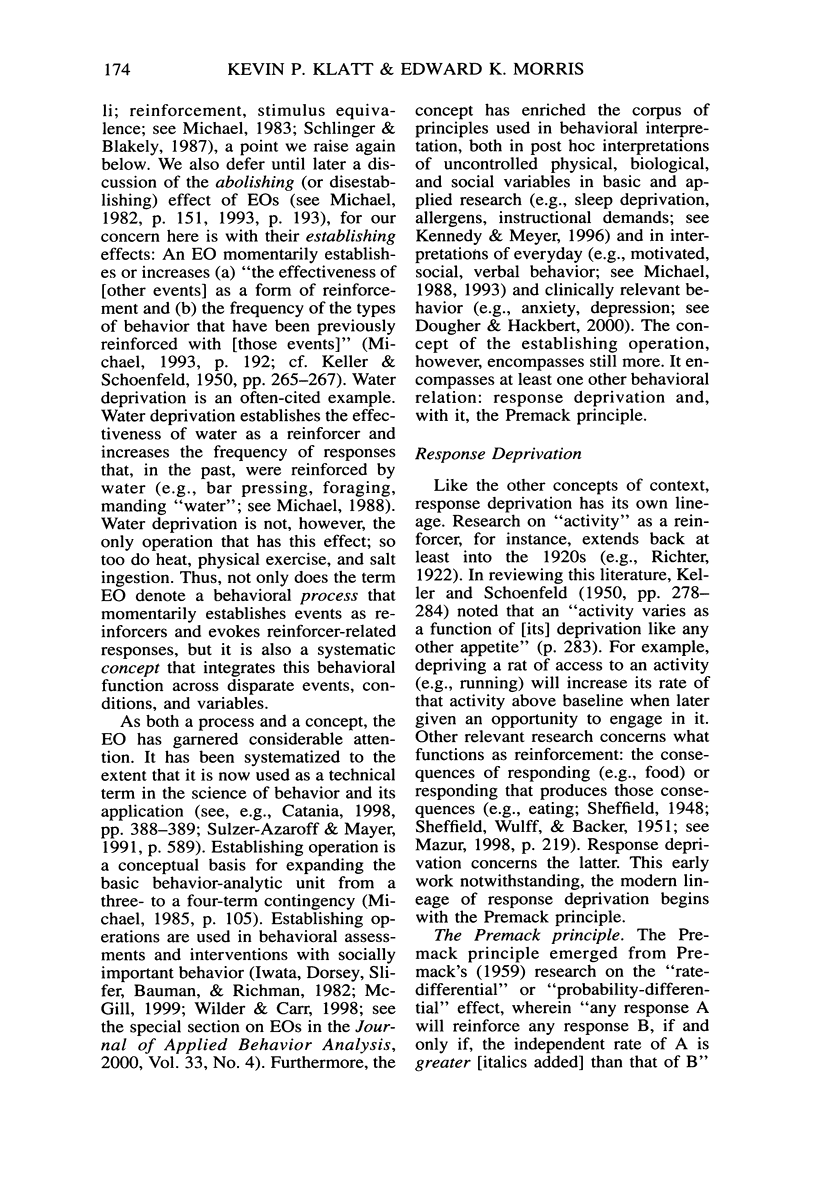
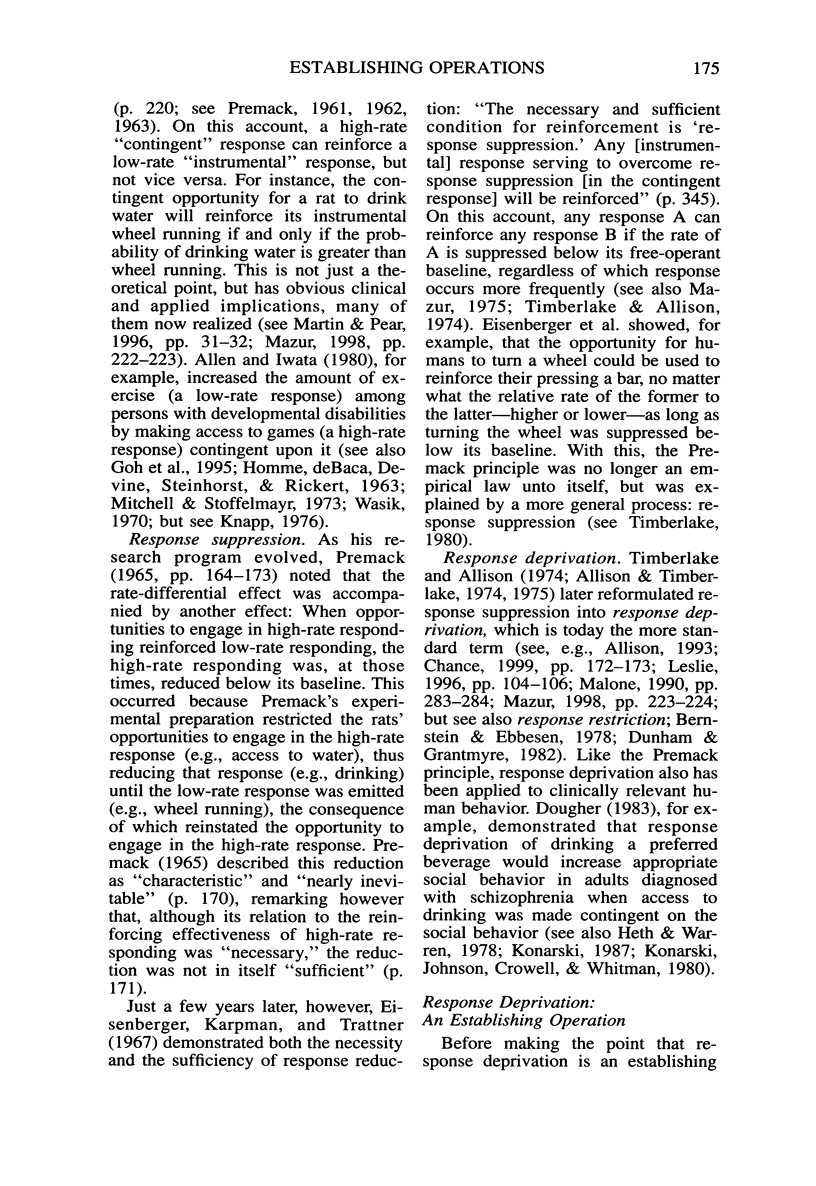
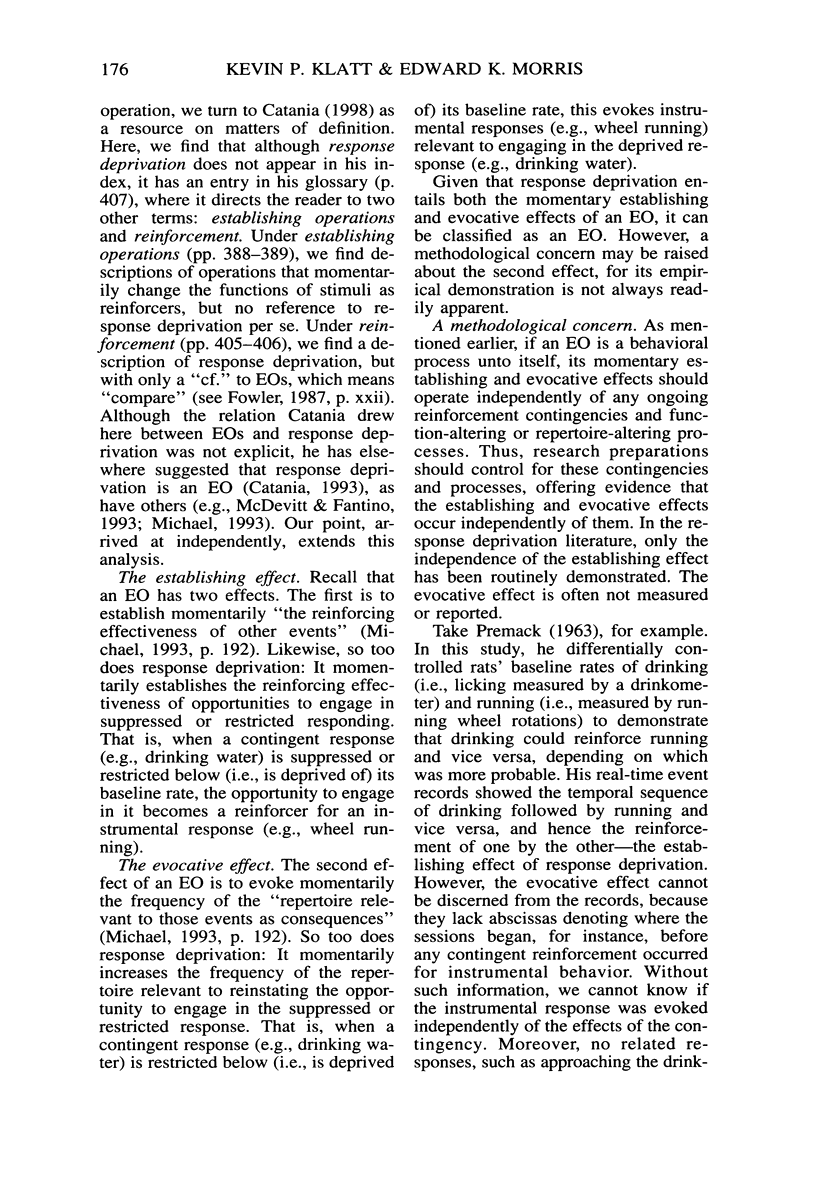
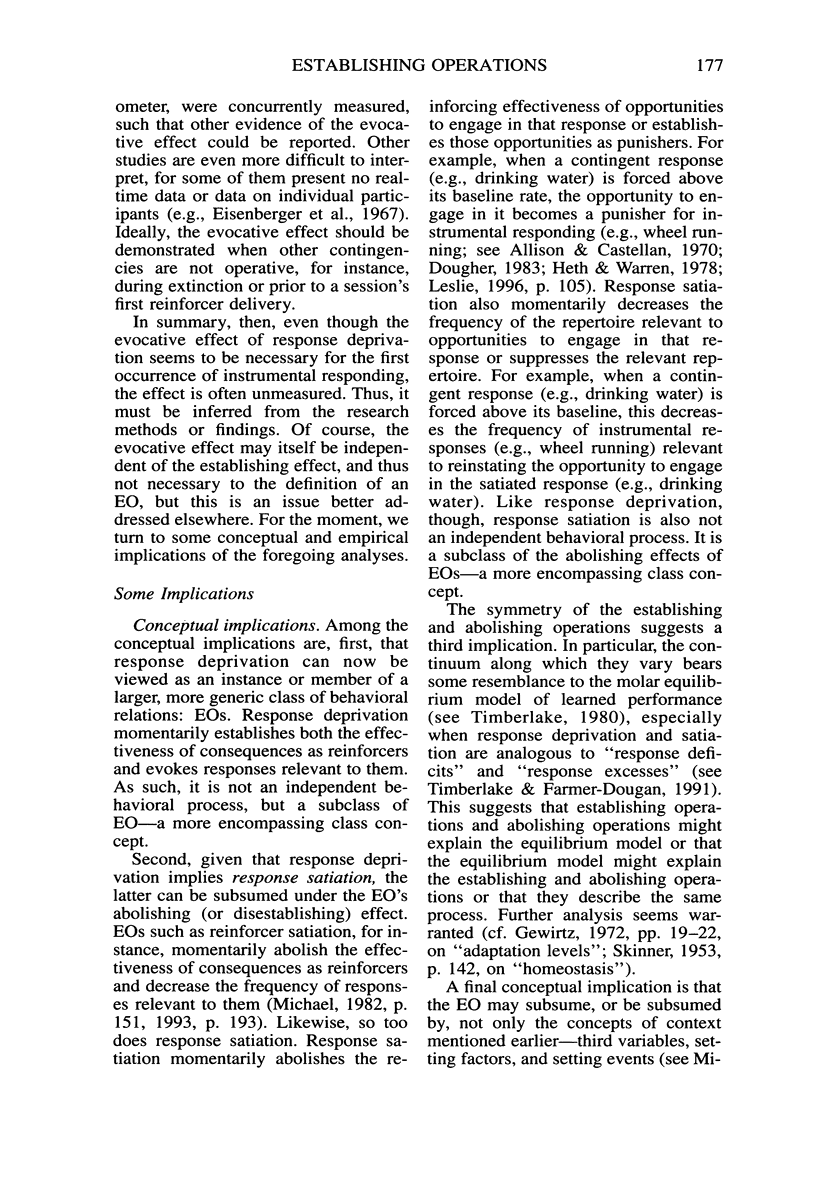
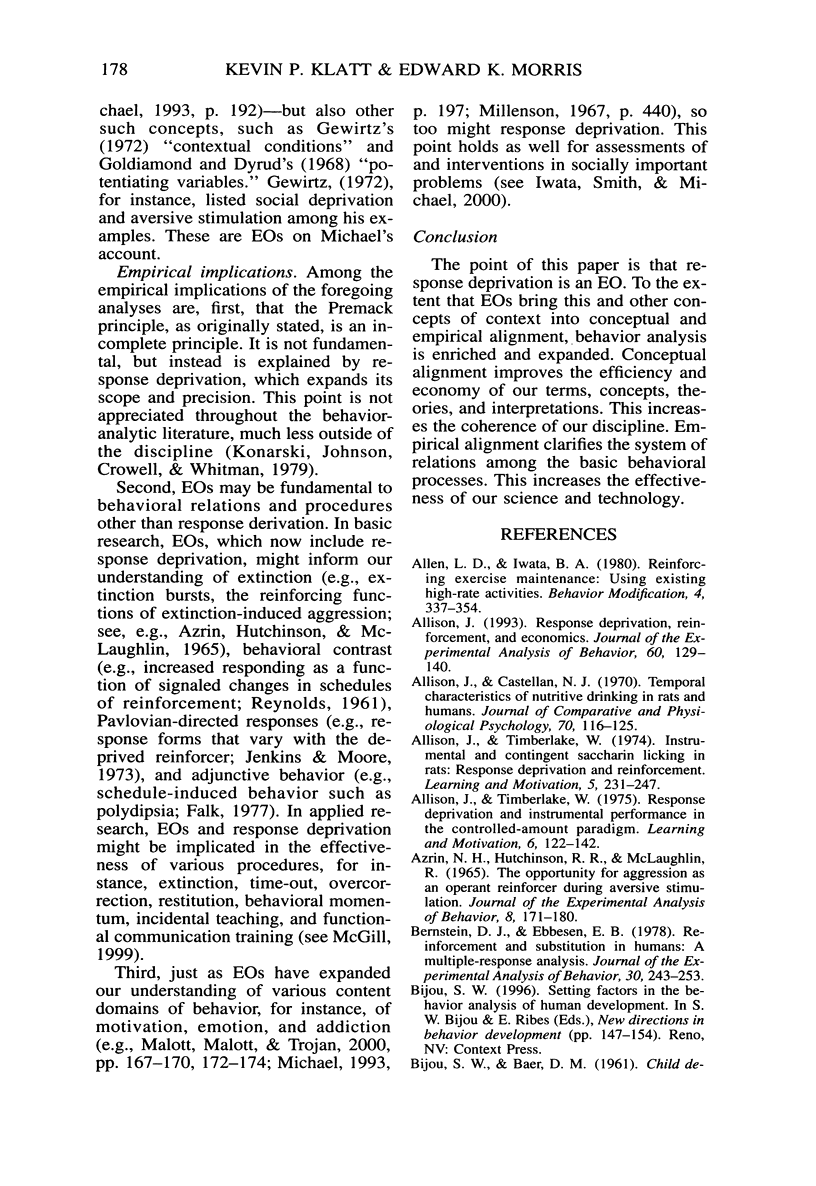
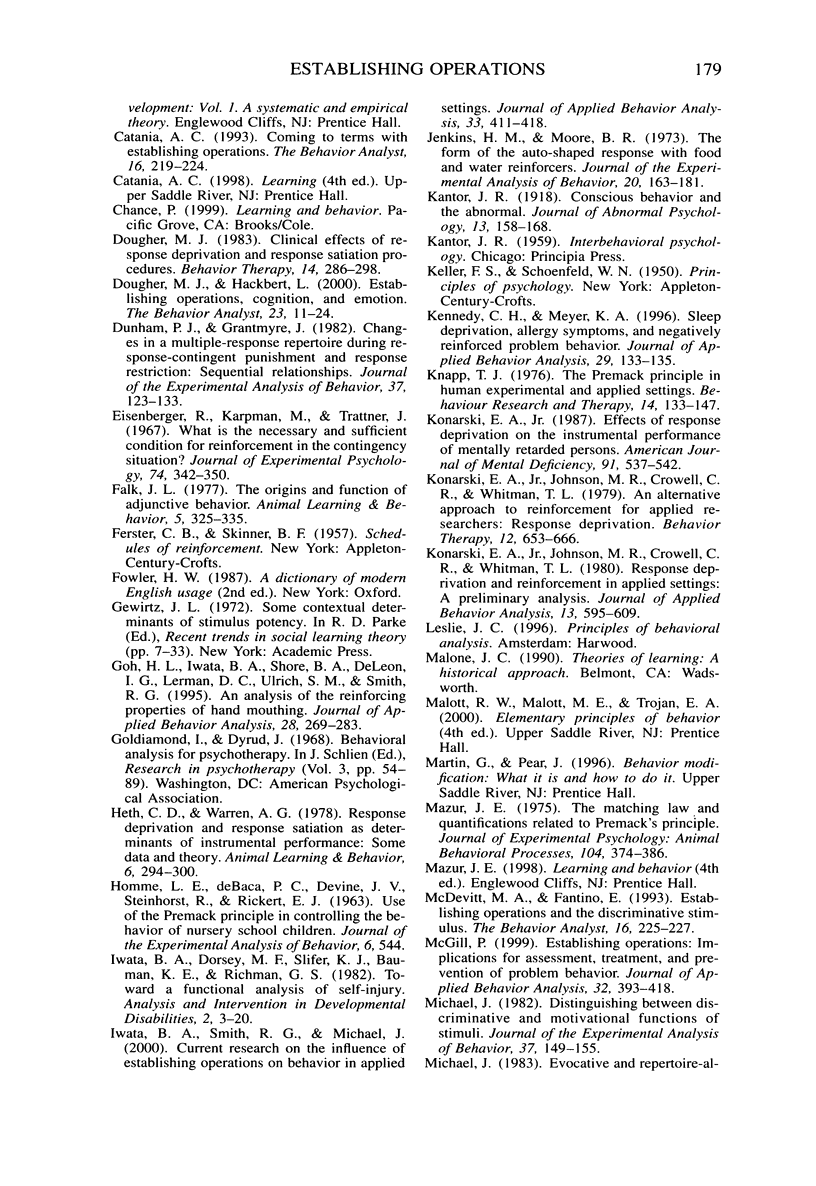
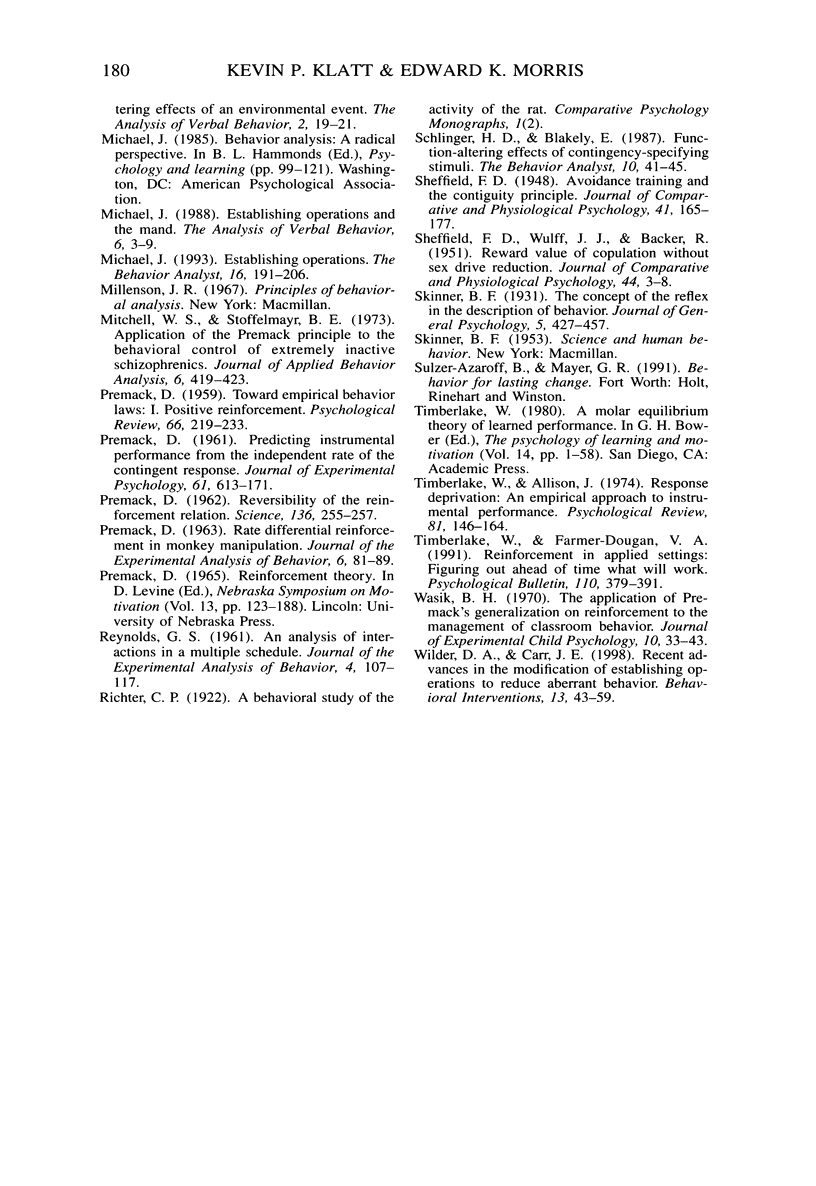
Selected References
These references are in PubMed. This may not be the complete list of references from this article.
- AZRIN N. H., HUTCHINSON R. R., MCLAUGHLIN R. THE OPPORTUNITY FOR AGGRESSION AS AN OPERANT REINFORCER DURING AVERSIVE STIMULATION. J Exp Anal Behav. 1965 May;8:171–180. doi: 10.1901/jeab.1965.8-171. [DOI] [PMC free article] [PubMed] [Google Scholar]
- Allison James. Response deprivation, reinforcement, and economics. J Exp Anal Behav. 1993 Jul;60(1):129–140. doi: 10.1901/jeab.1993.60-129. [DOI] [PMC free article] [PubMed] [Google Scholar]
- Bernstein D. J., Ebbesen E. B. Reinforcement and substitution in humans: a multiple-response analysis. J Exp Anal Behav. 1978 Nov;30(3):243–253. doi: 10.1901/jeab.1978.30-243. [DOI] [PMC free article] [PubMed] [Google Scholar]
- Catania A. C. Coming to terms with establishing operations. Behav Anal. 1993 Fall;16(2):219–224. doi: 10.1007/BF03392627. [DOI] [PMC free article] [PubMed] [Google Scholar]
- Dougher M. J., Hackbert L. Establishing operations, cognition, and emotion. Behav Anal. 2000 Spring;23(1):11–24. doi: 10.1007/BF03391996. [DOI] [PMC free article] [PubMed] [Google Scholar]
- Dunham P. J., Grantmyre J. Changes in a multiple-response repertoire during response-contingent punishment and response restriction: Sequential relationships. J Exp Anal Behav. 1982 Jan;37(1):123–133. doi: 10.1901/jeab.1982.37-123. [DOI] [PMC free article] [PubMed] [Google Scholar]
- Eisenberger R., Karpman M., Trattner J. What is the necessary and sufficient condition for reinforcement in the contingency situation? J Exp Psychol. 1967 Jul;74(3):342–350. doi: 10.1037/h0024719. [DOI] [PubMed] [Google Scholar]
- Goh H. L., Iwata B. A., Shore B. A., DeLeon I. G., Lerman D. C., Ulrich S. M., Smith R. G. An analysis of the reinforcing properties of hand mouthing. J Appl Behav Anal. 1995 Fall;28(3):269–283. doi: 10.1901/jaba.1995.28-269. [DOI] [PMC free article] [PubMed] [Google Scholar]
- HOMME L. E., DEBACA P. C., DEVINE J. V., STEINHORST R., RICKERT E. J. USE OF THE PREMACK PRINCIPLE IN CONTROLLING THE BEHAVIOR OF NURSERY SCHOOL CHILDREN. J Exp Anal Behav. 1963 Oct;6:544–544. doi: 10.1901/jeab.1963.6-544. [DOI] [PMC free article] [PubMed] [Google Scholar]
- Iwata B. A., Smith R. G., Michael J. Current research on the influence of establishing operations on behavior in applied settings. J Appl Behav Anal. 2000 Winter;33(4):411–418. doi: 10.1901/jaba.2000.33-411. [DOI] [PMC free article] [PubMed] [Google Scholar]
- Jenkins H. M., Moore B. R. The form of the auto-shaped response with food or water reinforcers. J Exp Anal Behav. 1973 Sep;20(2):163–181. doi: 10.1901/jeab.1973.20-163. [DOI] [PMC free article] [PubMed] [Google Scholar]
- Kennedy C. H., Meyer K. A. Sleep deprivation, allergy symptoms, and negatively reinforced problem behavior. J Appl Behav Anal. 1996 Spring;29(1):133–135. doi: 10.1901/jaba.1996.29-133. [DOI] [PMC free article] [PubMed] [Google Scholar]
- Knapp T. J. The Premack Principle in human experimental and applied settings. Behav Res Ther. 1976;14(2):133–147. doi: 10.1016/0005-7967(76)90067-x. [DOI] [PubMed] [Google Scholar]
- Konarski E. A., Johnson M. R., Crowell C. R., Whitman T. L. Response deprivation and reinforcement in applied settings: A preliminary analysis. J Appl Behav Anal. 1980 Winter;13(4):595–609. doi: 10.1901/jaba.1980.13-595. [DOI] [PMC free article] [PubMed] [Google Scholar]
- Konarski E. A., Jr Effects of response deprivation on the instrumental performance of mentally retarded persons. Am J Ment Defic. 1987 Mar;91(5):537–542. [PubMed] [Google Scholar]
- McDevitt M. A., Fantino E. Establishing operations and the discriminative stimulus. Behav Anal. 1993 Fall;16(2):225–227. doi: 10.1007/BF03392628. [DOI] [PMC free article] [PubMed] [Google Scholar]
- Michael J. Distinguishing between discriminative and motivational functions of stimuli. J Exp Anal Behav. 1982 Jan;37(1):149–155. doi: 10.1901/jeab.1982.37-149. [DOI] [PMC free article] [PubMed] [Google Scholar]
- Michael J. Establishing operations. Behav Anal. 1993 Fall;16(2):191–206. doi: 10.1007/BF03392623. [DOI] [PMC free article] [PubMed] [Google Scholar]
- Mitchell W. S., Stoffelmayr B. E. Application of the Premack principle to the behavioral control of extremely inactive schizrophrenics. J Appl Behav Anal. 1973 Fall;6(3):419–423. doi: 10.1901/jaba.1973.6-419. [DOI] [PMC free article] [PubMed] [Google Scholar]
- doi: 10.1901/jaba.1999.32-393. [DOI] [PMC free article] [Google Scholar]
- PREMACK D. Predicting instrumental performance from the independent rate of the contingent response. J Exp Psychol. 1961 Feb;61:163–171. doi: 10.1037/h0042090. [DOI] [PubMed] [Google Scholar]
- PREMACK D. Rate differential reinforcement in monkey manipulation. J Exp Anal Behav. 1963 Jan;6:81–89. doi: 10.1901/jeab.1963.6-81. [DOI] [PMC free article] [PubMed] [Google Scholar]
- PREMACK D. Reversibility of the reinforcement relation. Science. 1962 Apr 20;136(3512):255–257. doi: 10.1126/science.136.3512.255. [DOI] [PubMed] [Google Scholar]
- PREMACK D. Toward empirical behavior laws. I. positive reinforcement. Psychol Rev. 1959 Jul;66(4):219–233. doi: 10.1037/h0040891. [DOI] [PubMed] [Google Scholar]
- Reynolds G. S. An analysis of interactions in a multiple schedule. J Exp Anal Behav. 1961 Apr;4(2):107–117. doi: 10.1901/jeab.1961.4-107. [DOI] [PMC free article] [PubMed] [Google Scholar]
- SHEFFIELD F. D. Avoidance training and the contiguity principle. J Comp Physiol Psychol. 1948 Jun;41(3):165–177. doi: 10.1037/h0063072. [DOI] [PubMed] [Google Scholar]
- SHEFFIELD F. D., WULFF J. J., BACKER R. Reward value of copulation without sex drive reduction. J Comp Physiol Psychol. 1951 Feb;44(1):3–8. doi: 10.1037/h0060074. [DOI] [PubMed] [Google Scholar]
- Schlinger H., Blakely E. Function-altering effects of contingency-specifying stimuli. Behav Anal. 1987 Spring;10(1):41–45. doi: 10.1007/BF03392405. [DOI] [PMC free article] [PubMed] [Google Scholar]
- Timberlake W., Farmer-Dougan V. A. Reinforcement in applied settings: figuring out ahead of time what will work. Psychol Bull. 1991 Nov;110(3):379–391. doi: 10.1037/0033-2909.110.3.379. [DOI] [PubMed] [Google Scholar]
- Wasik B. H. The application of Premack's generalization on reinforcement to the management of classroom behavior. J Exp Child Psychol. 1970 Aug;10(1):33–43. doi: 10.1016/0022-0965(70)90041-x. [DOI] [PubMed] [Google Scholar]


